|
GETAC E100
Lightweight Rugged Tablet PC
(by Conrad H. Blickenstorfer -- view PDF version)
Getac introduced the E100 in early 2008 as a light, versatile rugged Ultra Portable Tablet PC for field and customer service applications. It's handy for sure, with a footprint smaller than that of a standard sheet of paper, and it weighs just a bit over three pounds. It feels sturdy, too, thanks to a magnesium housing, and the integrated numeric keypad makes rapid data entry easy. Four thick rubber bumpers clearly communicate that you don't have to baby this machine, it can take and survive a fall. You also quickly notice that the E100 is totally silent. There is no fan. Then you find out that this rugged little tablet also comes with a SmartCard reader, an ExpressCard slot, and that it can be equipped with integrated GPS and your choice of 3G wireless network connectivity, and things start looking quite interesting. Oh, and the display is sunlight-readable and the battery is strong enough to last almost four hours.

Built around McCaslin
McCaslin is the name of an ancient Irish/Scottish family, and also the code name of the processor in what Intel calls its Ultra Mobile Platform 2007 and describes as an "innovative collection of energy-efficient silicon building blocks and technologies designed to enable manufacturers to deliver a new category of small, truly mobile devices." There are two processors in that family, the super-efficient A100 and the somewhat punchier A110. The A110, which qualifies as an ultra low-power design, runs at 800MHz, has a 400MHz Front Side Bus, a small 512KB L2 cache, and a low TDP (Thermal Design Power) of just 3 watts. The processor is based on the tried and true Intel Pentium M architecture. It uses a 90 nm design (compared to the 45 nm technology in Intel's recently released "Atom" processors) and has seen duty in such innovative machinery as the HTC Shift, and now the Getac E100.
It'd be interesting to learn Getac's reasoning for selecting the A110. When it comes to mobile computers, size, weight, performance and battery life are all mutually exclusive and thus require optimization in the form of a series of carefully chosen tradeoffs. It's a quest for the best possible balance, with the goal of creating a device that is small and light, yet offers good enough performance and battery life. Each component -- processor, display, hard disk, memory, etc -- consumes so and so much energy and it all adds up to power consumption in watts. Now multiply the battery's voltage by its current and you get watthours. A Core Duo or Core 2 Duo processor has a power dissipation or Thermal Design Power (TDP) of about ten watts. A Core Solo processor lowers that to about 5.5 watts, and even that is still a lot compared to the A110's thermal design power of just three watts.
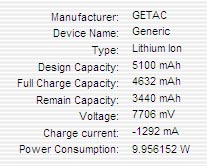 To put this in perspective, the E100 has a control panel that shows a variety of power statistics, including overall current power consumption. This is shown in the picture to the right. The last line shows that the machine draws just under ten watts. The E100's battery runs on 7.2 Volts and a current of 5,200 mAH. Multiply those two numbers and since volts x amps = watts, you get 37.5 watthours. Divide those 37.5 watthours by the ten watts the E100 draws, and you'd get a battery life of about 3.75 hours which is roughly what the machine gets.
To put this in perspective, the E100 has a control panel that shows a variety of power statistics, including overall current power consumption. This is shown in the picture to the right. The last line shows that the machine draws just under ten watts. The E100's battery runs on 7.2 Volts and a current of 5,200 mAH. Multiply those two numbers and since volts x amps = watts, you get 37.5 watthours. Divide those 37.5 watthours by the ten watts the E100 draws, and you'd get a battery life of about 3.75 hours which is roughly what the machine gets.
Now assume Getac had chosen a common Core 2 Duo processor, like the 1.2GHz U2500. With the processor drawing 10 instead of three watts, this would raise power consumption to 17 watts and reduce battery life to just over two hours. Do the math for a Core Solo with its 5.5 watt TDP and battery life would be three hours flat. So if battery life matters, then choosing the thrifty A110 processor makes sense. But what about the new Intel Atom processors that run faster and consume even less than the A110? Well, technology moves on. The A110 was available when Getac designed the E100, and the Atom was not.
What it really boils down to is whether the A110 processor is fast enough for the kind of applications customers use. The chip does not rival Core processors in any benchmarks, and was not meant to, but the Getac E100 feels quick enough in everyday use.
Excellent display
One interesting thing about Getac is that the company tends to understate the capabilities of its products. The screen of the E100, for example, is simply described as a "8.4" TFT SVGA transmissive display." It is that, but quite a bit more. Whereas other manufacturers of rugged equipment highlight the anti-reflective treatment and coating qualities of their displays, Getac doesn't mention daylight readability at all. You can get a superbright 800 nit display as an option and that is billed as sunlight readable. Ours didn't have the high-bright display and it was sunlight readable anyway. Judging by our experience with other sunlight readable displays, the E100's display definitely has both anti-reflective properties as well as anti-glare coating. You can clearly read it even in bright and direct sunlight. Not every display is sunlight readable and if I were Getac, I'd highlight that quality.
Below you can see the E100 in bright sunlight mid-day in early June. The display remains readable and there are none of the discolorations that often mar coated displays.
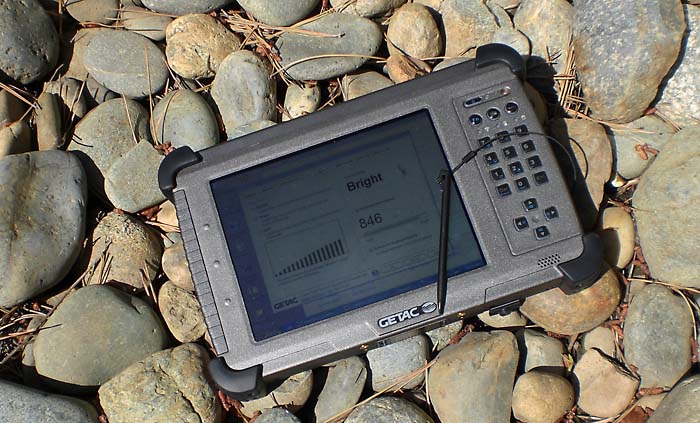
Below is a comparison between the Getac E100 and an older notebook convertible (Toshiba Portege 3500) that does not claim to be outdoor readable. This picture was taken at noon in the shade. You can see not only the brightness of the Getac display, but also its clarity.
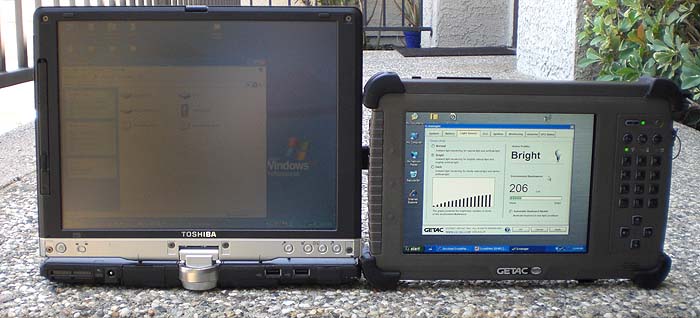
Touch screen
While dual panel input (both digitizer and touch) has become popular as of late with high-end units, Getac decided to ship the E100 either with a touch screen or with an electromagnetic digitizer, but not both. Our review unit had the resistive touch screen that can be operated either with the supplied plastic stylus or with a finger. The stylus is a small black plastic affair that'd be right at home on a Pocket PC. It securely fits into a garage indent on the right side of the unit where it is held in place by a rubber insert.
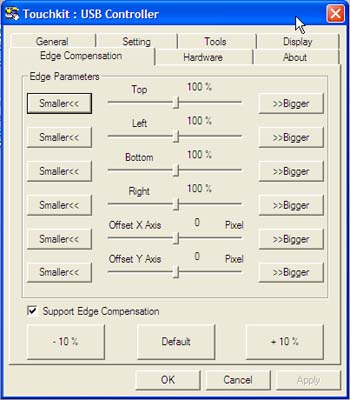 The E100's resistive touch panel controller communicates with the processor via USB and is very quick. A special Touchkit control panel adjustment and optimization for accurate touch performance and ease of use. The panel is quite elaborate. You can set linearization either to nine or 25 points, with 25 points offering maximum accuracy. You can also set double click time and area, beeps, auto right click, cursor stabilization, and five different mouse modes (like click on touch, click on release and so on) according to personal preference. I found it particularly nice that I could set the panel so a right mouseclick worked like with an active digitizer: tap and hold. The E100's resistive touch panel controller communicates with the processor via USB and is very quick. A special Touchkit control panel adjustment and optimization for accurate touch performance and ease of use. The panel is quite elaborate. You can set linearization either to nine or 25 points, with 25 points offering maximum accuracy. You can also set double click time and area, beeps, auto right click, cursor stabilization, and five different mouse modes (like click on touch, click on release and so on) according to personal preference. I found it particularly nice that I could set the panel so a right mouseclick worked like with an active digitizer: tap and hold.
If you intend to operate the E100 primarily with your fingers, you can set it so that the driver stops reporting points when movement is within a pre-defined range. This way the cursor will not jump around when the same point is touched again or when you move the stylus within a small area.
The Touchkit panel also offers extensive edge compensation controls. With touch screens and digitizers it can be difficult to touch or select items along the edge of the screen, and especially so when the LCD display runs all the way to the kind of thick protective bezel most rugged slate have. The E100 touch panel allows you to precisely define edge compensation for all four sides, i.e., set it so the cursor thinks the edge is either farther away or closer in. Precise configuration can make for optimal usability and responsiveness in touch applications.
Another quality of this touch screen is that it does not introduce any optical artifacts or distortions at all.
Design and construction
As stated, the E100 is a small and compact machine. It measures 11.1 x 7.2 inches and is an inch and a quarter thick. Our review unit weighed 3.25 pounds. Its magnesium-alloy housing is black in the rear and a warm gray in the front. The finish is matte textured in the rear and a very fine powder coat in the front. The overall look is defined by four thick rubber bumpers on the corners. They extend 3/8th of an inch on the sides, top and bottom, and also a good 1/8th of an inch above the front and rear surface. While not as elegant as fully integrated bumpers, these very clearly provide a lot of extra protection.
Now let's look at the four sides of the Getac E100:
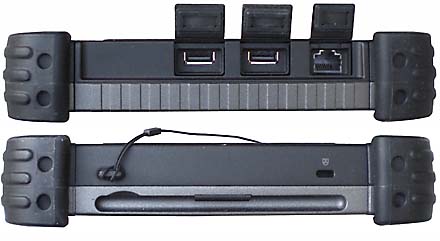 On the left side is a RJ45 Gigabit LAN connector and two USB 2.0 ports. All have separate rubber plugs. These ports are fairly deeply recessed, which means that some USB jacks and keys may need a short USB adapter cable with a slender jack.
On the left side is a RJ45 Gigabit LAN connector and two USB 2.0 ports. All have separate rubber plugs. These ports are fairly deeply recessed, which means that some USB jacks and keys may need a short USB adapter cable with a slender jack.
On the right side is an indent that serves as a garage for the 4-inch-long black plastic stylus. There is a string hole for the stylus tether should you want to use one.
Also present is a Kensington lock slot that lets you physically secure the computer with a Kensington wire cable.
On top is the audio jack, protected by its own rubber plug. Next to it is a compartment that can accommodate a Smart Card as well as a PC Card or ExpressCard (both ExpressCard/54 and the narrow ExpressCard/34 fit and are supported). It is protected by a plastic door with a thick rubber seal.
On the bottom you find the power connector, protected with a door with integrated rubber plug. There are two external antenna pass-through connectors, one for GPS and one for 3G radio. Between the antenna connectors is a 60-contact surface docking connector. Its pinless design means longer life.
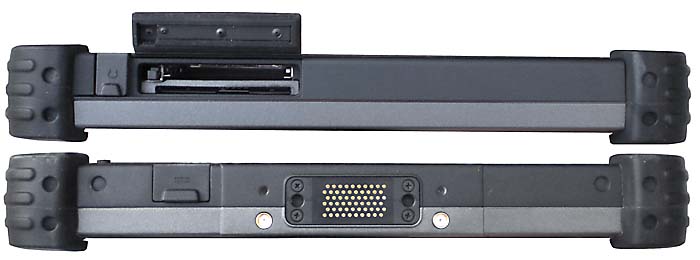
All the hinged protective plugs are made of tough plastic and attached to the unit with small screws. If they get damaged they can easily be replaced. The hinged plugs all have a soft rubber seal. Push them into place and they form a very effective friction seal. All covers are marked with the standard symbols for the ports they cover so they can easily be identified.
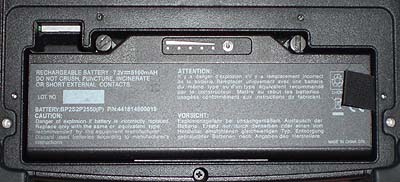 The backside of the E100 is devoid of the usual doors and compartments. There is no externally accessible memory expansion slot, no removable hard disk, and since the E100 does not have (or need) a fan, there is no heat exchanger or fan cover either. The only thing removable from the backside is the door to the battery compartment. It is held in place by four thumbnail (or coin) screws. A rubber seal prevents dust and water from entering.
The backside of the E100 is devoid of the usual doors and compartments. There is no externally accessible memory expansion slot, no removable hard disk, and since the E100 does not have (or need) a fan, there is no heat exchanger or fan cover either. The only thing removable from the backside is the door to the battery compartment. It is held in place by four thumbnail (or coin) screws. A rubber seal prevents dust and water from entering.
The picture above left shows the 5.2 volt/5,200mAh Lithium-Ion battery with the cover removed. Two more thumbnail-screws secure the battery. There is also a battery gauge that shows charge status upon pressing the button next to it. This comes in handy when you carry spare batteries around.
The E100's hard disk is shock-mounted somewhere inside the unit. Getac chose a 1.8-inch Toshiba MK1011GAH embedded 100GB disk that weighs no more than two ounces. Specially designed for small form factor devices (including iPod class devices), this 4,200 rpm drive uses perpendicular magnetic recording, a technology that can triple the storage density compared to the common longitudinal recording. Its very low power consumption of around one watt for reading and writing operations fits in well with a mobile device such as the E100 where battery life matters. Getac also sells the E100 with lower capacity 60 and 80GB drives.
Numeric keypad and function keys
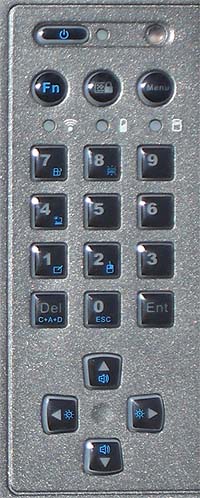 To the right of the display is a keypad arrangement that can work in conjunction with touch screen input or be the primary input method.
To the right of the display is a keypad arrangement that can work in conjunction with touch screen input or be the primary input method.
On top is the on/off key with an indicator light on the left, and next to that, on the right, the light sensor that can adjust backlight brightness.
Below that are three keys: function, keypad lock, and menu. The "menu" key brings up the OSDC utility, a very handy full-screen panel that easily lets you see and set functions.
Under this trio of round keys are three indicator lights for wireless (green for LAN, amber for WWAN), battery charge and disk activity. If the optional hard disk heater is installed, the disk indicator lights red when the heater is on, which happens when the machine is booted at temperatures below 40 degrees Fahrenheit.
The main part of the pad is taken up by a standard numeric keypad that provides a means for rapid data entry.
The function key toggles on and off. With it on,
- "1" switches the touch screen on and off,
- "2" issues a right mouseclick,
- "4" sets the screen backlight to manual, auto or maximum brightness,
- "7" rotates the display counter-clockwise by 90 degrees,
- "8" turns the keypad backlight on and off,
- "0" does an Esc, and
- "Del" an Alt-Ctl-Del.
The only problem here is that the blue function icons on the keypad buttons are tiny and very hard to make out, especially in dim light or with the keypad backlight on.
Below the keypad is a navigation diamond that is also used to control brightness and volume.
Function and left/right arrow on the navigation diamond steps through brightness levels in 60 increments. Function up/down raises and lowers audio volume in 25 increments.
All keys have sort of a liquid gel domed surface that makes them grippy, but light can reflect of it. When depressed, the keys provide tactile feedback as well as a clearly audible mechanical click.
Wireless and expansion
As is, the Getac E100 comes with a Bluetooth 2.0 EDR (Enhanced Data Rate) module and 802.11b/g WiFi. WiFi uses a RaLink module, but does not come with the RaLink software utility. Instead, the E100 uses the standard Windows Wireless Network utilities.
An integrated GPS receiver is optionally available. I installed Google Earth to see if it would recognize the internal GPS, but, sadly, the GPS option is only available for paying Google customers.
For Wide Area Network communication, there are CDMA/EVDO/1xRTT (Sprint, Verizon, etc) and HSDPA/UMTS/EDGE/GSM (AT&T, T-Mobile, etc) options.
As far as expansion goes, there is a combination PC Card and ExpressCard slot. This means the E100 can accommodate a large variety of PC Cards and card formats that fit into a PC Card adapter. It also supports both the 54mm and the 34mm ExpressCard standard.
The unit also has a Smart Card reader in the same compartment as the PC Card slot.
Security
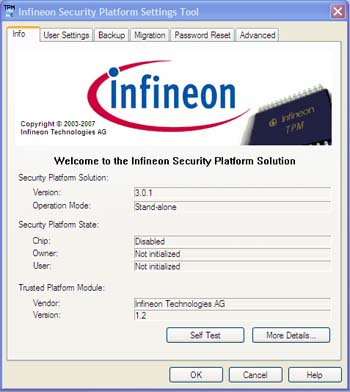 As part of its security, the Getac E100 uses Trusted Platform Module (TPM) hardware to create and manage computer-generated digital certificates. Combined with software, these certificates can be used to: As part of its security, the Getac E100 uses Trusted Platform Module (TPM) hardware to create and manage computer-generated digital certificates. Combined with software, these certificates can be used to:
- Send and received secure email,
- Set up the browser for client identification,
- Sign Word macros,
- Encrypt individual files or entire folders, and
- Create secure network connections.
To use TPM, you have to enable TPM support in the BIOS and then configure the system with the supplied Infineon Security Platform Settings Tool (shown to the right).
The Infineon setting tool is a wizard that guides you through the entire process from initial user settings where you set your basic password, configure secure email and encryption, and manage certificates; to making backups of all the security settings, secure drives, and credentials; to migration of security credentials from one platform to another; password resets; and advanced topics like owner passwords, enhanced authentication, emergency recovery, and system and user-specific security policies.
All of this can get pretty involved. Some users may never implement TPM or even passwords, whereas others may be set up in accordance with their company's IT security procedures, or they may configure an individual system for maximum security.
Over all this, don't forget physical security and get a Kensington locking cable to use with the Kensington slot on the right side of the unit. It is inexpensive insurance against theft.
Getac G-Panel
The E-100 comes with a number of special utilities and helper apps that make using the unit quicker and simpler. For example, instead of going to bring up the standard Windows control panels, which can be a pain if you're using your fingers to operate the slate, the Getac G-Manager combines a variety of functions into one tabbed utility.
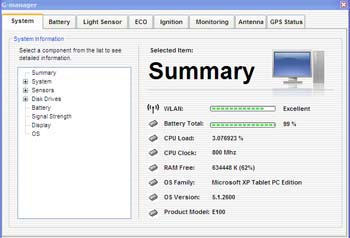
- Summary provides a one-look summary of all major data, including battery status, CPU load, wireless LAN signal strength, free RAM and so on. You can also drill down for more detailed and technical data.
- Battery shows % left in a large numeral, plus just about any other battery statistic you may want. It also shows the current power consumption. With the backlight at maximum, the reading was 14.0 watts, with the backlight at minimum that dropped to 9.8 watts.
- Light Sensor shows you the profile chosen (normal, bright, dark). It also shows environment illuminance in Lux as measured by the light sensor.
- ECO displays and controls power savings settings. You can customize the settings and even have certain features such as Bluetooth, WiFi or the touch screen turned off.
- Ignition lets you set the shutdown delay for vehicle-mounted and -powered units when the vehicle's engine is stopped.
- Monitoring lets you graphically view a dozen parameters. They are superimposed on the screen along the right edge.
- Antenna controls antenna behavior when docked.
- GPS Status shows satellites and summary GPS data.
The OSDC Utility
The OSDC utility is another very handy screen that easily lets you see and set functions. Everything is very large so you can see it even under bad lighting conditions and so you can operate it with your fingers. There are also five "Quick Buttons" that can be programmed to bring up whatever the user needs.
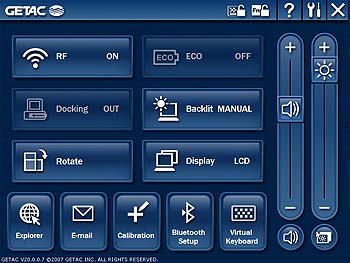
- RF lets you quickly turn wireless on and off.
- ECO switches the system power saving mode on and off.
- Docking shows "IN" if the tablet is docked. You can turn off power to the dock even with the E100 inserted.
- ECO displays and controls power savings settings. You can customize the settings and even have certain features such as Bluetooth, WiFi or the touch screen turned off.
- Backlight cycles through normal, maximum and auto backlight.
- Rotate rotates the display counter-clockwise in 90 degree increments.
- Display cycles through LCD, external display, and both if an external display device is connected to the dock.
On the right side are handy sliders for brightness and volume, and along the bottom are five programmable soft buttons that can launch applications or trigger other events.
Tablet PC functionality
The Getac E100 uses the Tablet PC Edition of Windows XP (it is also Vista ready). As such, it has all the special pen and ink utilities that add a whole new dimensions to computing, such as Windows Journal. Electronic ink is a terrific way to quickly annotate, doodle, edit, or highlight.
However, as far as all that Tablet PC functionality goes, those who want to take full advantage of things like electronic ink for drawing or jotting down notes in Windows Journal should probably consider the electromagnetic digitizer version of the E100. The touch screen is primarily designed for tapping and touching. You can draw on it, but handwriting recognition works as well (see example in the input panel below), but not as well as with the electromagnetic digitizer.

You can optimize the touch screen for drawing by disabling cursor stabilization in the touch control panel and also set the Constant Touch Area as small as possible. This gives better control over the cursor when writing or drawing.
Ruggedness
The Getac E100 is a rugged computer capable of absorbing rough handling and demanding environmental conditions. The magnesium-alloy housing with its large protective rubber bumpers on all four corners makes the unit virtually immune to casual damage. We especially appreciate the thick bumpers as they not only provide excellent impact protection, but also keep the machine from getting scratched. That's because no matter how you sit the unit, it always rests on the rubber bumpers and never on the metal surface iself.
As for environmental specs, the standard E100 has an operating temperature range of 32 to 140 degrees Fahrenheit. A low temperature (4 to 132 degrees Fahrenheit) is available. Getac does not supply a drop spec in feet, but mentions MIL-STD-810F, Method 516.5. That usually implies 26 4-foot drops as MIL-STD-810F says, "Levels for this test were set by considering how materiel in the field might commonly be dropped. (For example, a light item might be carried by one man, chest high; thus it could drop 122 cm (48 inches).
According to Getac, operating and storage humidity, thermal shock, vibration, mechanical shock, crash shock, solar radiation, low pressure, and salt fog resistance were all tested according to methods mandated in MIL-STD-810F.
Getac also lists compliance with a variety of governing standards and regulations in various markets. These can be difficult to summarize in a review and they also vary depending on markets. Inquire with Getac.
Sealing is at IP54 level, where the "5" means the unit is protected against dust, and the "4" means it is protected against water spray from all directions.
Computers like the Getac E100 will be used in a wide variety of locations and scenarios. The machine is light enough to be carried around on the job all day, but many will be used in a vehicle, on shopfloors or any number of other locations where they will need a dock or some sort of a secure mounting solution. The image below shows a number of RAM Mount mounting solutions from National Products.

RAM Mounts offers both a passive cradle for just mounting, and a powered cradle/dock that also serves as a port replicator. The powered dock has two USB ports, a serial port, a video output, a RJ45 LAN port, two RF pass-throughs, and a power jack. The cradles and docks can be mounted several different ways:
- A square rail clamp accommodating various size rails
- A universal vehicle mount
- A pipe mount for use with 1-1/4 to 1-7/8 inch diameter tubing
- A drill-down flat surface mount
- A double suction cup mount
Both the passive and the powered docks can be used with any of the five mounting systems, and also with any other RAM-Mount component. [See RAM Mounts for the Getac E100]
Bottom line
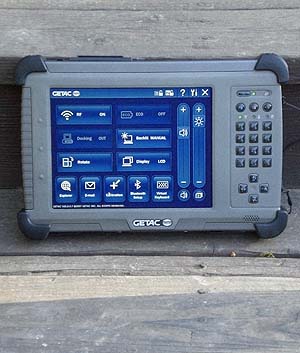 The E100 replaces the somewhat larger Pentium M-based CA27 in Getac's lineup. The new tablet is much lighter, weighing just over three pounds. It also has an integrated numeric keypad and additional hardware keys, allowing rapid data entry in the field.
The E100 replaces the somewhat larger Pentium M-based CA27 in Getac's lineup. The new tablet is much lighter, weighing just over three pounds. It also has an integrated numeric keypad and additional hardware keys, allowing rapid data entry in the field.
Despite its light weight, a sturdy magnesium-alloy housing and ample protection via four thick rubber bumpers provide exemplary ruggedness. The computer is also properly sealed against dust and water. Almost all ports have their own protective hinged rubber plugs that can easily be replaced should they get damaged.
The E100's 800 x 600 pixel SVGA display offers very good sunlight readability that can be enhanced with an optionally available high-bright (800 nits) backlight. Even without the option the screen is more readable in sunlight than most.
The standard E100 comes with a very configurable, speedy touch screen that lends itself to operation with a stylus or with fingers. Those who want to take full advantage of inking and other pen-specific capabilities of the Windows XP Tablet PC Edition may want to opt for the also available electromagnetic digitizer.
In order to facilitate light weight and decent battery life (up to four hours in our tests), Getac chose the very energy-efficient Intel A110 chip. While providing battery life and the ability to run without a fan, this is not a high performance chip and customers should determine if it's quick enough for their intended applications.
Overall, the E100 provides plenty of functionality and expansion potential in a handy, lightweight tablet that offers good battery life and excellent sunlight readability.
-- Conrad H. Blickenstorfer
GETAC E100 Specs:
| Type |
Rugged pen tablet
|
| Processor |
800MHz Intel A110 with 512KB L2 Cache and 400MHz front side bus |
| Display Chipset |
Intel 945GM Express |
| OS |
Windows XP Professional, Tablet PC Edition
|
| Memory |
512MB/1024MB DDR2 |
| Display |
8.4" SVGA (800 x 600) TFT; optional 800 nit panel available with touchscreen version |
| Digitizer |
Resistive touch screen (electromagnetic digitizer option available) |
| Keyboard |
Optional external USB |
| Storage |
Shock-mounted 1.8" 4200RPM Toshiba MK1011GAH 100GB embedded hard disk
|
| Expansion slots |
1 PC Card Type II/Express Card34/54, Smart Card
|
| Housing |
Magnesium |
| Size |
11.1 x 7.2 x 1.25 |
| Weight |
3.25 pounds with battery (as tested)
|
| Operating temperature |
32 to 140 degrees Fahrenheit (low temperature option: 4 to 132 degrees Fahrenheit) |
| Ingress protection |
IP54 compliance |
| Drop/shock/other |
MIL-STD-810F tested: vibration (514.5), humidity (507.4), shock/drop (516.5), thermal shock (503.4); Regulations: various FCC, UL, TUV, CE, CB |
| Power |
7.2 Volt/5,200mAh Li-Ion 37.5 watt-hour ("up to 5 hours"); optional add-on 7,800mAH battery |
| Interface |
2 USB 2.0, RJ45 Gigabit LAN |
| Wireless options |
Ralink USB 802.11b/g, Bluetooth; optional EV-DO, GPRS/EDGE/UMTS/WCDMA/HSDPA, GPS, "mission boxes" with RFID, barcode, mag stripe
|
| Price |
depends on configuration |
| Contact |
GETAC us.getac.com |
(copyright 2008 RuggedPCReview.com)
|








